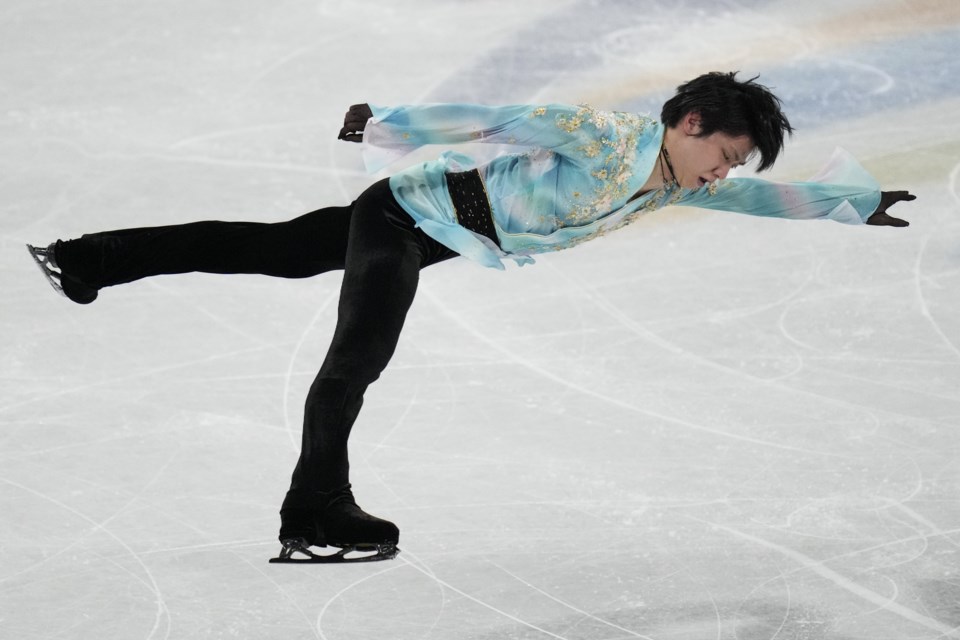BEIJING — Yuzuru Hanyu hoped to leap four and a half revolutions into figure skating's history books.
In one of the most anticipated moments of the men's singles event at the Beijing Olympics, the Japanese superstar had hoped to become the first skater in history to land a quad Axel in competition. In eighth place after the short program, he had nothing to lose. But the two-time Olympic champion fell as soon as his blade touched the ice upon landing.
Twelve years after American Evan Lysacek won the Vancouver Olympics without a quad in his programs, skaters reel off the four-revolution jumps -- the Axel is actually four and a half -- seemingly with ease.
Male skaters don't only need a quad to reach the Olympic podium, they often need several. American Nathan Chen won gold on Thursday with a perfect balance of artistry and athleticism, landing five quads in his free skates. ¬Ý
Canada's Keegan Messing could sense a seismic shift coming in his sport after the 2014 Sochi Olympics.¬Ý
"I told my coach, 'Next Olympics, someone's going to do a five-quad program,'" Messing said.
Chen, often referred to as the "Quad King," did one better at those next Olympics. Sitting in 17th after a disastrous short program at the 2018 Pyeongchang Games, he did six quads in his free skate, an Olympic first that nearly got him onto the podium.
"And then here (in Beijing), we have how many people doing four or five quads in the program?" Messing said. "And it's just absolutely amazing, the level that the sport has grown in the last eight years, it's astounding.¬Ý
"This is by far the strongest I think the men's event has ever been in the history of figure skating, and to be a part of it is just a privilege, and an honour to be skating with these amazing athletes."
Messing had two quads in his free program Thursday, but downgraded one to a triple, a costly error in the quad-heavy field. He finished 11th.
Quads are the highest-scoring technical element in singles skating. Quads, like other technical elements, also earn extra points if they're executed in the second half of a skater's program. Chen had one in the second half of his program, while Hanyu had two, which helped him climb from eighth place up to fourth despite a pair of falls.
American Jason Brown has become almost famous for his absence of quads. His superb skating skills, musicality and connection with the audience has earned him a legion of fans, but it hasn't been quite enough to put him on an international medal podium.
He was sixth on Thursday, and the only athlete in the event's final flight of the top six skaters with nary a quad.
“I think our sport is such a beautiful combination," Brown said. "It’s unbelievable to see the technicians pushing the sport technically and I’m blown away and think so highly of them and I respect them so much.
“It's also making sure that that other side isn’t forgotten about and I want to keep pushing it and proving that there’s so much value to that and I’m going to constantly give it my all," Brown added. “If I could push the sport technically I would. That being said, I’m not willing to give up that artistic side because that is what I fell in love with and makes me — me."
Canada's three-time world champion Patrick Chan once said the quad revolution had turned his sport into a "slam dunk contest." Like Brown, he worried about the jumps taking away from the artistry of the sport. He was concerned about the toll that countless hours of practising them took on young skaters' bodies.¬Ý
A quad jump happens in less than a second. Skaters leap almost two feet in the air, and reach rotational speeds of more than 400 rpm. They land with the force of seven times their body weight, on blades barely thicker than a loonie.¬Ý
Kamila Valieva made history on Monday by becoming the first woman to land a quad in Olympic competition. The 15-year-old Russian star actually landed two. A cloud of controversy now hangs over the teen with reports she tested positive for a banned heart medication.
Canada could have its own "quad king" soon in Stephen Gogolev. The 17-year-old became the first Canadian to land three different quads in a program in 2018, when he was just 13. Gogolev was ruled out of Canada's Olympic trials last month when he tested positive for COVID-19 upon arrival in Ottawa.
Canada's Kurt Browning landed the first-ever quad in competition in 1988, while Japan's Miki Ando was the first woman to do so, in 2002.¬Ý
This report by The Canadian Press was first published Feb. 10, 2022.
Lori Ewing, The Canadian Press


